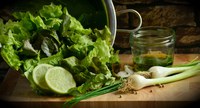Prairie Fare: What is the Best Way to Clean Fresh Veggies?
(Click an image below to view a high-resolution image that can be downloaded)
By Julie Garden-Robinson, Food and Nutrition Specialist
NDSU Extension
“We should have enough green beans for dinner,” I said.
“Oh, yes, we have lots of green beans,” my older daughter said while lifting a bushy plant with numerous dangling green beans. “Look at all the blossoms for more beans.”
My daughter always has been my harvest helper. Weeds, however, are not her favorite thing to pick. That’s usually my job, unfortunately.
This would have been an idyllic harvest scene if the temperature outside was less than 95 degrees.
The beans were nearly “precooked.” We should have harvested earlier in the day.
As we rinsed and trimmed the vegetables for dinner, I thought about some of the questions that I have had related to cleaning fresh vegetables in our kitchens.
Is rinsing with water good enough for cleaning fresh produce at home? Should you soak leafy greens and other vegetables? How about adding some vinegar? What about using soap or another detergent? Or should you rinse them in a commercial produce detergent?
In general, plain, cold water from your tap is the usual recommendation for rinsing produce. Researchers have put the other questions to the test.
If you are harvesting a cantaloupe or other produce with thick or netted skin, use a vegetable brush to help remove soil and other contaminants.
Soaking leafy greens for a couple of minutes in clean water followed by draining and rinsing has been shown to reduce bacteria effectively on the surfaces of fresh produce.
Soaking for a longer time, such as 30 minutes, is not more effective.
I use a large bowl and clean, cold tap water. If you are using your sink, be sure to clean it thoroughly.
Some people add vinegar to the soak water (1/2 cup vinegar to 2 cups water), and that will reduce bacteria but not eliminate it.
However, a vinegar-water soak also could make your produce taste like pickles.
How about adding a squirt of dish soap to the water or to the outside of a melon?
Washing fruits and vegetables with soap and water is not recommended.
Unfortunately, during the pandemic, people were using soaps and sanitizers to clean their fruits and vegetables. That really wasn’t helpful on several levels.
The virus was not spread through food, according to the Food and Drug Administration. Further, consuming dish soap residues can lead to diarrhea or vomiting, which is what you are trying to avoid by proper cleaning of produce.
Do commercial produce rinses do a better job than water in reducing bacteria and reducing pesticide residues?
The University of Maine put a commercial wash to the test. They compared “Fit” brand fruit and veggie produce wash with distilled water. They found that using either distilled water or Fit detergent was about equal in reducing bacteria and pesticide residues.
They used distilled water because it has been filtered to remove contaminants.
The commercial produce rinse adds an additional cost. Because both cleaning methods were effective, the researchers recommended using distilled water or cold tap water to clean produce. A two-minute soak, especially for broccoli or lettuce, was effective in helping dislodge soil.
Bottom line: Be sure to rinse fresh produce whether you harvested it yourself or bought it at a farmers market or grocery store.
I have one exception: Bagged salads labeled “ready to eat” do not need to be rinsed.
Finally, before you begin any food preparation, be sure to wash your hands with warm, soapy water, and be sure your cutting boards and knives are clean.
After rinsing your produce, use a clean paper towel to drain or dry the produce. This will remove more potential contaminants. Store in your refrigerator within two hours of preparing.
Here’s a salad dressing you can personalize to suit your own tastes. Enjoy with a mixture of leafy greens.
Create Your Own Personalized Salad Dressing
1 c. oil (canola, sunflower, olive oil, etc.)
1/3 c. acid (red wine vinegar, balsamic vinegar, etc.)
1 tsp. garlic powder
1 tsp. onion powder
1 tsp. salt
1/2 tsp. ground black pepper
Optional ingredients (sugar; mustard; chopped peaches; minced onions; chopped red, green or orange peppers)
Whisk together or place in a covered glass jar and shake.
Makes about 21 servings. Each serving (about 1 tablespoon) has 90 calories, 10 grams (g) fat, 0 g carbohydrate, 0 g protein and 115 milligrams sodium.
(Julie Garden-Robinson, Ph.D., R.D., L.R.D., is a North Dakota State University Extension food and nutrition specialist and professor in the Department of Health, Nutrition and Exercise Sciences. Follow her on Twitter @jgardenrobinson)
NDSU Agriculture Communication - July 8, 2021
Source: Julie Garden-Robinson, 701-231-7187, julie.garden-robinson@ndsu.edu
Editor: Ellen Crawford, 701-231-5391, ellen.crawford@ndsu.edu




